




























The concerns that should shape IT strategies are transforming in recent times. IT now firmly seen as a business enabler, has the dual role to enable and secure the company’s growth trajectory. IT modernization is key to expanding the Business’s horizons, in terms of both enhanced digital services on offer as well as reaching out to new markets and customers.
For the typical CIO, modernizing legacy systems, adopting cloud technologies, and leveraging emerging technologies such as AI or Gen AI, IoT, etc are top priorities on the agenda. At the same instance, they need to ensure their systems, applications, and data are secure in the context of the ever-rising threats of data breaches. Meeting regulatory requirements such as GDPR is also a requirement that they need to address.
The cloud, seen as the gateway to digital transformation has seen rapid adoption over past several years with further acceleration during the pandemic years. Now companies are reassessing their cloud strategies in a bid to enhance agility and scalability while driving down costs of operations. Multi-cloud has been a popular choice which allows companies to benefit from the best services of different cloud providers while also ensuring that they avoid vendor lock-in. Going further, enterprises also need to decide whether some workloads are still best kept on-prem even as they adopt a digital-first strategy. In this, they must ensure that there is absolute seamlessness in the hybrid model with technologies that extend from the cloud to manage on-premises platforms and provide support with no compromise.
And for large organizations that have large legacy systems, taking the route of digital acceleration is perhaps done best in a phased approach as the conversation with Endava’s MD for the region David Boast (featured in this issue) suggests. This ensures transformation milestones are achieved without disrupting the ‘heritage’ and in an iterative manner.
R. Narayan Editor in Chief, CXO DX










14
Enterprises reassess their cloud strategies to optimize their consumption of best fit IT services.
Jishanth Karunakaran, Founder and CEO at Mindfire Technologies, discusses how the company is consolidating and accelerating its growth as a trusted service provider.
David Boast, Managing Director - MENA, Endava discusses the company’s value propositions to its customers.
Fissal Oubida, General ManagerMEA, CIS and the Indian Subcontinent, Lexar discusses how Lexar has increased focus on meeting the growing demand of its storage solutions in the photography segment.
Edwin Weijdema, Field CTO & Lead Cybersecurity Technologist says paying ransoms via insurance money is slowly dying out and companies in need of cyber insurance are increasingly required to meet minimum security and ransomware resilience standards.
Jim Chappell, Global Head of AI and Advanced Analytics, AVEVA, has been working with a artificial intelligence for 30 years. He explains why the technology is at a critical juncture.
12 » NETWORK INFRASTRUCTURE, A PRIME TARGET FOR CYBER THREATS IN 2023
13 » HUAWEI ANNOUNCES PARTNERSHIPS WITH PAYTABS
CPQ offers the flexibility to individualise customisable offerings for each customer, independent of scale writes Vibhu Kapoor, Regional Vice President - MEA & India, Epicor.
Mihir Shukla - CEO and Co-founder, Automation Anywhere and Dinesh Chandra - Regional Vice President, MET discuss the company’s focus on enabling enterprises to accelerate their transformation.
As Generative AI grips the region, we must take steps to ensure its responsible use writes Sid Bhatia, Regional VP & General Manager, Middle East, Turkey & Africa, Dataiku.
Sarah Nicastro, VP of Customer Engagement at IFS and Creator of Future of Field Service, argues that the industry needs to move to more advanced AI that creates a unique service fingerprint for continual sustainable optimization.


Veeam Data Cloud launches all-in-one storage, cloud backup and ransomware recovery for Microsoft Azure and Microsoft 365 – which currently protects over 18 million users

Veeam Software, a leader by market share in Data Protection and Ransomware Recovery, announced the new Veeam Data Cloud, which is built on Microsoft Azure and delivers the confidence and reliabili-
ty of the industry’s leading platform with the ease and accessibility of a cloud service. Today, Veeam Data Cloud provides backup-as-a-service (BaaS) for Microsoft 365 and Microsoft Azure, enabling radical resilience and leveraging powerful data protection and security technology within a simple, seamless user experience.
“According to the Veeam Data Protection Trends Report 2024, 88% of enterprises were either very likely or almost certain to use a Backup as-a-Service (BaaS) or Disaster Recovery as-a-Service (DRaaS) for at least some of their production servers,” said Anand Eswaran CEO at Veeam. “As the #1 global provider of data protection and ransomware recovery and the leader in backup for Microsoft 365, we're bringing those trusted capabilities - for Microsoft 365 and for Microsoft Azure - and delivering them as-a-service. These new as-a-service offerings, which are offered
through the Veeam Data Platform, give companies the option of simplifying the management and administration of their backup operations with all the cyber resiliency and reliability of Veeam technology.”
The cloud native design of the Veeam Data Cloud and the compatible data platform of Microsoft Azure, provides the best protection for Microsoft 365 and Microsoft Azure data, instantly ready out-ofthe-box with policy-driven simplicity. The architecture is built on Zero Trust principles and leverages Azure Blob Storage isolated from production environments, is continuously versioned and maintained, and keeps backups safe, secure, and ready for fast recovery. This all-in-one service includes backup software, infrastructure, and storage, which keeps costs low and predictable while simplifying management.
Local cloud data center will provide customers with enhanced cloud-based security
Cisco announced its plan for a new local cloud data center in the UAE for its Duo multifactor authentication (MFA) and secure access solution. Set to launch in mid-2024, the new data center will support businesses of all sizes in strengthening their cybersecurity posture and improving connection performance.
H.E. Dr. Mohammed Hamad Al-Kuwaiti, Head of Cybersecurity of the UAE Government, said, “Our goal is to build a safe and resilient cyber infrastructure in the UAE that enables citizens to fulfill their aspirations and empower businesses to thrive. The announcement of the Cisco Duo cloud data center in the UAE is important for supporting organizations in responding to the ever-changing cyber risks of the digital age and will contribute to a strong cyber defense ecosystem that protects critical infrastructure and prevents cyberthreats.”
The launch of the cloud data centre in Dubai is part of Cisco’s and Duo's strategy to build security infrastructure globally that helps prepare customers for the future.
"As companies across the globe continue to strengthen their se-
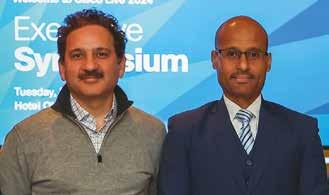
curity efforts, it is more crucial than ever to establish a secure infrastructure that safeguards organizations from the growing threat landscape," said Raj Chopra, Senior Vice President and Chief Product Officer for Cisco Security. "Cisco puts identity at the center of our security strategy, leveraging Duo's capabilities to keep customer data highly secure, and enabling them to focus on providing the best user experience for their customers."
MISA enables close collaboration between members with the shared goal of improving customer security
Acronis, a leading provider of cyber protection, announced it has become a member of the Microsoft Intelligent Security Association (MISA), an ecosystem of independent software vendors (ISV) and managed security service providers (MSSP). MISA members have integrated their solutions with Microsoft security technology to build a better defense against a world of increasing cybersecurity threats.
Acronis advocates for natively integrated applications and services commonly used by service providers to boost productivity and efficiency. Acronis Cyber Protect Cloud is an advanced single, integrated solution that reduces complexity and provides unmatched integrated protection from ever-evolving cyber threats. It also encompasses the Acronis Ecosystem of more than 200 integrations with third-party vendors.
"Over 20,000 MSPs use Acronis to protect and manage their customers' endpoints, applications, and data," said Gaidar Magdanurov, President at Acronis. "Most of them are Microsoft CSP Direct or Indirect Resellers who seek synergies between Microsoft, Acronis, and other vendors to meet customer security and data resiliency requirements. With today’s announcement of Acronis’ Cyber Cloud Protect integrated with Microsoft Intune, MSPs can now manage customer endpoints with Microsoft Intune and deploy Acronis managed security and backup services quickly and easily to their customers, all from a single agent and interface.”
The integration between Acronis Cyber Protect Cloud and Microsoft Intune allows partners to deploy Acronis agents and apply protection plans based on Microsoft Entra ID groups through Microsoft Intune, which adheres to Microsoft best
practices. Acronis partners can now seamlessly explore integration options directly through the MISA partner catalog, aiming to provide MSPs with a more accessible experience for efficiently enabling an integrated ecosystem.
The vendor aims to double its B2B and large enterprises business segment in the next five years

Kaspersky has appointed seasoned IT leader, Toufic Derbass, as the Managing Director for the Middle East, Türkiye
and Africa (META) region. With nearly three decades of experience, Toufic aims to build on Kaspersky’s strong regional presence of over 16 years as the company aims to double its B2B and large enterprises business segment in the next five years.
Toufic is committed to bettering relations with regional governments and policymakers, in addition to promoting Kaspersky’s award-winning products and services as the region rapidly adopts digitization. His efforts will also focus on elevating the level of cybersecurity awareness in the region, contributing to Kaspersky’s mission of building a safer world.
Prior to joining Kaspersky, Toufic held leading positions at multinational soft-
ware companies, where he was responsible for scaling businesses by forging strategic partnerships and executive relationships with leading private and public sector organizations.
Commenting on his appointment, Toufic Derbass, Managing Director for META at Kaspersky, said, “I’m honored and excited to lead a brand that is globally known for its innovation and is built on a legacy of over 26 years. Kaspersky’s strong market footprint in the Middle East, Türkiye and Africa region is a testament to its breadth and quality of products and services, that blend technology with human expertise. My vision for Kaspersky in the region is to showcase its unique capabilities, such as the revolutionizing concept of Cyber Immunity which plays a crucial role in reimagining cybersecurity.”
The strategic move will help SAS Partners to deliver SAS’ powerful AI solutions at a larger scale
SAS, a global leader in data and AI, has selected multibillion-dollar technology distributor and innovator Redington as its new distribution partner for the Middle East,
Africa and Turkey (META). SAS has doubled down on its partner strategy in recent months, shifting to a new distribution model for SAS® solution provider partners (resellers) to deliver its cutting-edge software to more customers across industries and geographies. The agreement with Redington will provide affected SAS Partners in these regions with expanded reach and resources to generate more value, not only for their own businesses but also for customers who are seeking to maximize the impact of their data with SAS solutions.
With a strong presence across the META region, Redington’s robust network, including 290 international brands, connects channel partners to create value and drive digital transformation. These efforts pair well with SAS’ many industry-specific solutions – in addition to SAS Viya, SAS’ end-to-end, cloud-based data and AI platform. Redington will also provide channel
partners with in-region sales, enablement and recruitment support, including training workshops, tailored programs and marketing expertise. SAS’ dynamic AI, analytics and data management offerings, joined with Redington’s robust ecosystem, present partners and customers alike with a powerhouse combination for innovation and growth.
“Redington is reimagining the digital future by empowering the channel community to become trusted digital consultants. We do this by equipping partners with cutting-edge solutions and services from leading global brands that will enable end customers to achieve business outcomes. The digital future that we are helping to create will be defined by increased efficiency, enhanced customer experiences and improved profitability,” said Dharshana Kosgalage, Head of Technology Solutions Group at Redington META.
Courses to be made available through the scholarship program to increase the number of certified CIP professionals
OPSWAT, a global leader in perimeter defense cybersecurity solutions for critical environments, announced that it is launching a $10 million scholarship program to offer essential CIP training courses. This initiative is designed to address the increasing demand for certified cybersecurity professionals, particularly within critical infrastructure industries.
ICS2 estimates in its 2023 Cybersecurity Workforce Study that 4 million cybersecurity professionals are needed globally, marking a significant 13% increase from 2022. The CIP landscape has become more complex, requiring expertise in safeguarding both Information Technology (IT) and Operational Technology (OT). Additionally, the data sharing between these domains, coupled with complex technologies, intensifies the need for specialized knowledge around how to protect
it. OPSWAT recognizes these challenges and is committed to bridging the skills gap in this specialized field.
In response to the urgency outlined by the U.S. Executive Orders and the National Cybersecurity Strategy, OPSWAT's scholarship program will provide OPSWAT Academy courses through authorized partnerships with educational institutions and government agencies. These collaborations aim to empower both students and seasoned professionals by offering them free access to courses that cover the latest technologies in cybersecurity.
"Through our commitment to education and workforce development, OPSWAT is taking a significant step towards closing the cybersecurity skills gap," said Benny Czarny, Founder and CEO at OPSWAT. "Our goal is to ensure that individuals, regardless of their
 Benny Czarny Founder and CEO, OPSWAT
Benny Czarny Founder and CEO, OPSWAT
background, have the opportunity to develop their cybersecurity expertise and join OPSWAT’s mission in protecting the world’s critical infrastructure."
Partner Care delivers 24x7 Administrative and Operational Support to boost channel partner profitability
Sophos is expanding its commitment to the channel with the addition of Partner Care, a new offering in its global partner program that features a dedicated, 24x7 team of Sophos experts who handle nonsales related questions and operational support. The offering is designed to speed up response times for Sophos partners and Managed Service Providers (MSPs) needing assistance with administrative and operational tasks, freeing them up to focus on selling and securing their customers with Sophos’ portfolio of innovative managed services and endpoint, network, email, and cloud security solutions.
“Based on our decades of experience successfully supporting partners who sell to mid-market and small business organizations, we know that administrative and operational issues take away valuable time needed to build customers relationships, pursue prospects and close new
business deals,” said Kendra Krause, senior vice president of global channels and small business sales at Sophos. “Partner Care reinforces Sophos’ longstanding strategy to be ‘channel-best,’ which is our commitment to provide partners with optimal, conflict-free revenue and profitability opportunities, curated training and support, and advanced security solutions that defend customers from data breaches, ransomware and other debilitating cyberattacks.”
Sophos Partner Care offers a single point of contact for quoting, navigating the partner portal, addressing licensing queries, Not For Resale (NFR) requests, and more. With this high level of service, partners working with small and mid-market organizations can better boost their productivity and increase profitability.
To help further partners and MSPs with their
 SVP,
SVP,
awareness of critical industry issues, Sophos provides real-time and historical threat intelligence from its Sophos X-Ops unit, a cross-functional team of more than 500 Sophos cybersecurity experts worldwide.
Transformation includes digital core migration to SAP S/4HANA and Microsoft Azure for data-centric operations.

Advansys announced its acquisition of FORTE CLOUD – a Cloud Service Provider and Consulting Partner. The acquisition is one of the main milestones in achieving Advansys aggressive expansion plan. This acquisition is not just a merger of two entities, but a fusion of expertise
and innovation. Advansys will incorporate FORTE CLOUD's expansive range of cloud services, including advanced cloud architecture and migration solutions. This integration is set to revolutionize Advansys’s portfolio driving unprecedented value for customers and partners alike.
“FORTE CLOUD is a strong, strategic fit for Advansys and the combination of our two companies will drive significant value for both our partners and customers” said Advansys Chairman and CEO, Ahmed ElMoghazy. “FORTE CLOUD's leading services in the MEA region will add to Advansys, creating a world-class portfolio of offerings. Also, the addition of exceptional talent to our team brings in new expertise and proficiency.”
As the two companies join forces, Ahmed ElMoghazy has been appointed as the Chairman and CEO of FORTE CLOUD, Abdelrahman Elposhi has been appointed as the Chief Technology Officer, Yasser Mamdouh has been appointed as the Chief Financial Officer, and Moheeb Darwish as the Chief Commercial Officer.
New end-to-end API security and AI capabilities make it easier for customers to protect their AI-powered applications
F5 has announced new capabilities that reduce the complexity of protecting and powering the exploding number of applications and APIs at the heart of modern digital experiences.
As AI accelerates the growth of applications and the APIs that connect them, F5 is bringing API code testing and telemetry analysis to F5 Distributed Cloud Services, creating a comprehensive and AI-ready API security solution. F5 also announced it is making AI pervasive across its entire solution portfolio with intelligent capabilities that help customers protect against sophisticated AI-powered threats, while making it easier to secure and manage multicloud application environments.
“Companies already face daunting complexity and a rapidly changing threat landscape. The added pressure to secure and deliver AI services compounds this, putting many security and IT teams in an
untenable position,” said François Locoh-Donou, President and CEO, F5. “We are delivering new capabilities that ensure our customers are ready for AI, making it significantly easier for them to protect and power every app, every API, everywhere.” As AI drives growth in the volume of apps and APIs, it is adding significant security challenges that companies must solve. New AI-driven digital experiences are highly distributed with a mix of data sources, models, and services spread across on-premises, cloud, and edge environments, all connected by an expanding network of APIs. The protection of these API connections and the data that runs through them is the critical security challenge that companies must face as they deploy more AI-enabled services.
To address this challenge, Distributed Cloud Services will now offer the industry’s most comprehensive, AI-ready API security solution. The addition of capa-
bilities recently acquired from API security innovator Wib enables vulnerability detection and observability in application development processes, ensuring that risks are identified and policies implemented before APIs enter production.
Developer with luxury projects across UAE implements Salesforce and AI solutions to deliver new applications and boost customer satisfaction

Arada, a leading UAE developer, is expanding its use of Salesforce solutions, tapping the power of generative AI to transform its ability to utilise data, manage its operations, and boost customer experience across its operations. The fast-growing developer has digitally transformed its business operations using Salesforce Sales, Service and Marketing Cloud, including Salesforce Einstein and Salesforce Field Service, leveraging generative AI to
drive insights and innovation across its operations.
As part of Arada’s digital transformation strategy EVOLVE – an ambitious transformation program to make technology a driver of business innovation – Arada joined hands with Salesforce at an enterprise scale to leverage its complete platform for end-to-end property life cycle management solutions, which covers Sales Cloud, Service Cloud, Marketing Cloud, and the Lightning platform for rapid development activities.
This enabled Arada to transform its sales, CRM and marketing functions from end-to-end - encompassing lead generation, onboarding of customers and visibility across the customer lifecycle. This has empowered sales, operations and customer services teams to understand customers better, deliver a unified and improved level of service, and boost sales.
By adding Salesforce Einstein and Field Service to its existing suite of Salesforce solutions, Arada is well-positioned to consolidate and continue its rapid growth, and to drive further IT innovation, including the development of a ‘super app’ through which the company will deliver a broad range of services.
Full-stack observability from anywhere: SolarWinds provides visibility across the hybrid digital estate with options for self-hosted, cloud-native SaaS, or a combination of both
SolarWinds has announced enhancements to its SaaS-based and self-hosted, on-premises observability solutions built to monitor and observe complex, distributed environments from anywhere. The AI-powered enhancements enable teams to manage onprem, hybrid, or cloud-native ecosystems with full-stack visibility across networks, infrastructure, databases, applications, user experiences, and security through a unified, integrated solution available either on-premises or in the cloud.
SolarWinds enables enterprises to integrate on-prem and cloud ecosystems into one holistic view—so they can improve the user experience and increase performance through proactive issue detection and accelerated problem-solving.
“The rapidly evolving technology landscape and organizations’ ongoing modern-
ization journeys drive the digital complexity they face. When operating in a hybrid, multi-cloud, containerized microservices world, there’s one thing we know for sure: this complexity isn’t magically going away,” said Cullen Childress, SolarWinds SVP, Product. “At the same time, uptime and service level requirements continue to become more stringent while budgets remain stagnant. For nearly 25 years, we’ve given IT pros the tools they need to do their jobs more easily and with greater satisfaction. That’s why our message today is clear: with SolarWinds, you can see everything from anywhere.”
The new capabilities in SolarWinds observability solutions include further enhancements to its proven broad and deep network and infrastructure Observability, offering complete hybrid visibility across on-premises and cloud networks. This

includes on-premises and cloud network devices, virtual machines, hypervisors, containers, Kubernetes, and infrastructure-as-a-service resources.
Expanded solution brings cloud infrastructure, SaaS apps and externally exposed assets together for a unified view of risk across multi-cloud environments
Qualys has unveiled TotalCloud 2.0, a significant upgrade to Qualys’ AI-powered cloud native application protection platform (CNAPP) that delivers a single prioritized view of cloud risk and is the first to extend its protection to SaaS applications.
The shift toward multi-cloud and SaaS environments presents organizations with the opportunity for innovation and agility but also introduces complex security challenges. This has led to the
adoption of numerous security tools, each providing different and sometimes conflicting perspectives on the organization’s risk level. Navigating these diverse risks across fragmented environments poses a challenge for organizations, impeding effective risk prioritization, reporting and remediation.
"Efficiently managing risk and responding quickly to threats or attacks on cloud workloads is challenging for organizations,” said Melinda Marks, practice director, Cybersecurity at Enterprise Strategy Group. "Qualys TotalCloud 2.0 provides a unified platform to identify and consolidate all cloud data across diverse multi-cloud environments, providing broader visibility and context for efficient remediation of security issues. This approach fosters improved collaboration among security, IT, and development teams, to efficiently mitigate risk and protect business-critical applications."
TotalCloud 2.0 with TruRisk Insights provides a single, prioritized view of cloud risk. The solution correlates unique indicators from diverse Qualys sources, such as Cloud Workload Protection (CWP), Cloud Security Posture Management (CSPM), and Cloud Detection and Response (CDR).
Healthcare was the top targeted industry this year, as adversaries maintained their focus on entities with cybersecurity weaknesses

Cisco Talos Intelligence Group, one of the largest commercial threat intelligence teams in the world, released its annual report, titled ‘Cisco Talos: Year in Review 2023’. The report highlights the most common attacks, targets, and other significant trends across the threat landscape in 2023.
The findings show that suspicious network traffic captured by Cisco Security products revealed sharp increases in activity often corresponded with major geopolitical events and global cyberattacks. The report also revealed that LockBit maintained its position as the top global ransomware threat for the second consecutive
year, with healthcare emerging as the primary target due to funding constraints and low downtime tolerance.
Commenting on the report’s findings, Fady Younes, Senior Director for Cybersecurity at Cisco in the Middle East and Africa, said: “Talos yearly report contains a wealth of insights about how the threat landscape has shifted. With the complexity of cybercrimes that is mounting every year, we are proud of Cisco’s global presence and Talos’ world-class expertise that is providing us with a massive amount of data to research — endpoint detections, incident response engagements, network traffic, and much more. This data is avail-
able for our customers and partners to support our efforts in strengthening cybersecurity resilience in the region.”
Top Threats Observed in 2023 include:
Network Infrastructure Threats: Talos observed an increase in sophisticated attacks on networking devices this past year, particularly by state-sponsored actors seeking to advance espionage objectives and facilitate stealthy operations. Exploitation of vulnerabilities and weak credentials remains a persistent concern, with three of the five most targeted device vulnerabilities being critical or severe.
Ransomware and Pre-Ransomware Incidents: Ransomware and pre-ransomware incidents continue to affect customers at a consistent rate — totaling the same 20 percent of Talos IR incidents as last year — with health care being the most targeted vertical. LockBit continues to dominate the ransomware landscape, and affiliates accounted for more than 25 percent of the total number of victim posts on data leak sites across some 40 ransomware groups monitored by Talos IR.
Telemetry Trends: Cisco's telemetry revealed increased suspicious network traffic during major geopolitical events. Common file extensions were abused, and well-known brands were spoofed, highlighting the use of social engineering for operations like phishing and business email compromise (BEC). Adversaries are likely responding to Microsoft’s disabling of macros in 2022 by using different file types to hide their malware, such as PDFs, which was the top blocked file extension this year.
At Mobile World Congress (MWC) 2024, Huawei Cloud announced new partnership agreements with Saudi Arabia-based Zode and UAE-based PayTabs. These collaborations are intended to collectively drive the innovation and implementation of cloud and AI technologies in diverse industry use cases.
Alan Qi, President of Huawei Cloud Middle East and Central Asia, emphasized that these Memorandum of Understandings (MoUs) signifies more than just the integration of Huawei Cloud's innovative strengths in line with the partners' development objectives. “It represents a strong acknowledgment from both parties towards shared goals and a steadfast commitment to pushing the boundaries of the digital and intelligent era in Saudi Arabia and the UAE. Huawei Cloud is dedicated to collaborating with partners, exerting continuous efforts to achieve even more fruitful outcomes, and collectively opening a new chapter of digital transformation,” said Qi.
The agreement between PayTabs and Huawei will enable both companies to jointly explore and develop digital payments and payment orchestration technology to launch more innovative payment services across the region. The agreement was signed in the presence of Abdulaziz Jouf, CEO and founder of PayTabs Group; Hany O. Soliman, Regional Head and Operating Partner for PayTabs GCC and Africa; Samy Masoud, VP, Solutions Delivery PayTabs; Mark Chen, President of Huawei Cloud Solution Sales, and Sebastian Shi, CEO of Huawei Cloud UAE.
This partnership will inject new vitality into the business development for both PayTabs Group and Huawei Cloud, bringing more possibilities to grow the fintech ecosystem and unleash smoother, secure payment experience for global consumers. As one of the world's top five cloud service providers and the fastest-growing cloud in the Middle East, Huawei Cloud will provide a solid cloud foundation to
support PayTabs and other leading fintech enterprises in the region to expand their business locally and globally.
In addition to the technology foundation, Huawei Cloud will share its expertise from operating in more than 170 countries and regions to become a bridge for PayTabs to connect markets, expand business, and achieve business success.
Zode and Huawei Cloud officially signed a strategic cooperation agreement, aiming to deepen technological innovation and cooperation and jointly promote the rapid development of the e-commerce industry in Saudi Arabia. Sami Alahmadi, CTO of Zode, and Alan Qi, President of Huawei Cloud Middle East and Central Asia, attended the signing ceremony.
Together, Zode and Huawei Cloud will jointly accelerate Zode's journey to becoming a leading Internet e-commerce platform in the Arab world. This will bring a more convenient and smooth shopping experience to regional consumers and inject new vitality into the e-commerce market in Saudi Arabia and the Middle East. The new agreement will also include Arabic AI services to help Zode’s e-commerce platform run more efficiently.
Huawei Cloud's robust cloud services and partner ecosystem have already enabled Zode to improve product versatility, network quality, customer experience, and operational efficiency. Furthermore, Huawei Cloud provided extensive compute, storage, database, network, SMS, and security services to help Zode build a solid e-commerce cloud foundation. With Huawei Cloud's support, Zode developed its e-commerce platform within nine months.
As the central hub for Huawei Cloud services in the Middle East, Central Asia, and Africa, Huawei Cloud Riyadh Region has been offering cutting-edge and innovative, reliable, secure, and sustainable cloud services to customers in Saudi Arabia and beyond since its launch in September 2023. Huawei Cloud Riyadh Region has been deployed with three Availability Zones (AZs) to deliver cutting-edge and innovative, highly reliable, low-latency, and secure cloud services. This ensures the excellent operation of customer services on Huawei Cloud. Not only does this Region cover major network carriers like STC, Zain, and Mobily, but it also offers a comprehensive range of cloud services, including robust infrastructure, databases, containers, big data, and AI services.

Enterprises reassess their cloud strategies to optimize their consumption of best fit IT services
Organizations that have adopted cloud services over the years, to meet their IT requirements, have done so with relative differences in their respective strategies. There has always been a choice to go for a private cloud or a public cloud or adopt a hybrid model and continue to use some on-prem IT as well. Cloud adoption guaranteed digital acceleration and resilience during the Covid years across verticals.
Now, with cloud regions of large cloud providers available locally, public cloud consumption continues to rise with data sovereignty issues addressed to a good extent. However, companies are now beginning to reassess their cloud strategies which is a smart thing to do, to optimize their consumption of best fit IT services. Several factors go into setting up a cloud strategy.
Ramakrishnan Natarajan, VP, Information Technology at Emirates Hospitals Groups says, “The strategy selection for cloud or on-premises workloads within enterprises is fundamentally influenced by several key factors. The intrinsic values, practices, and priorities of an organization significantly shape its approach to adopting cloud or on-premises solutions. The comprehensive analysis of direct and indirect costs associated with each option plays a crucial role in determining the most cost-effective and strategic choice for the enterprise. The alignment of the cloud or on-premises strategy with the company's expansion and scaling plans is essential to support its long-term objectives. Further, adherence to industry-specific regulations and standards dictates the need for specific data handling and processing capabilities, influencing the choice between cloud and on-premises solutions.” He adds, “Many organizations now favor a multi-cloud approach, emphasizing the importance of service availability. The hybrid cloud model has become increasingly prevalent, as it combines the benefits of both cloud and on-premises environments, offering a versatile and balanced solution. This model is particularly appealing because it allows organizations to leverage the scalability and flexibility of the cloud while maintaining critical workloads on-premises for enhanced control and security. Private clouds and on-premises infrastructures remain vital, especially in contexts where data privacy and control are paramount. As enterprises continue to navigate their digital transformation journeys, the shift towards more nuanced, hybrid, and multi-cloud strategies reflects a maturing understanding and adoption of cloud technologies, tailored to meet specific organizational needs and challenges.”
Many enterprises have now over the past few years walked the talk as far cloud first strategy goes. And now they need to recalibrate how best to optimize on the road ahead.
Jayaraj Perumalsamy, General Manager – Group Digital, Information & Technology, Barakat says, “We prioritize a "cloudfirst" strategy while acknowledging the importance of leveraging diverse cloud models to meet business needs efficiently. We have

embraced Multi-Cloud Adoption, utilizing multiple providers for flexibility. We have Seamlessly Integrated our hybrid cloud strategy, combining on-premises and cloud environments. We have also optimized the private cloud for handling sensitive workloads.” Spiralling costs One of the promised benefits of cloud adoption has been reduced costs vis-à-vis investments sunk in on-premises infrastructure and services. Fast forward to the present day and spiralling costs with the cloud is a reality that CIOs grapple with. Cost management on cloud spending is a concern that needs tackling.
Jayaraj says, “As IT leaders, we are actively managing rising cloud costs by prioritizing cost management and implementing optimization strategies such as rightsizing instances. We streamline development and operations through DevOps practices to ensure efficient resource utilization. Continuous monitoring allows us to proactively control costs by identifying optimization opportunities and fine-tuning cloud resources. Additionally, setting budgets and usage caps, leveraging automation, security tools, alongside hybrid cloud approaches, and financial management tools enables us to effectively balance costs while maximizing returns.” As organizations grow and their usage of cloud services increases, expenses can rise significantly, especially if there are no effective cost control and monitoring practices in place. Fac-
tors like unused resources, unoptimized service selections, and lack of budget oversight can contribute to escalating costs.
Ramakrishnan says, “Cost management in cloud spending is a critical aspect that IT decision-makers need to address. Effective cost management ensures that cloud expenses are aligned with the organization's budget and objectives. It involves monitoring usage, optimizing resource allocation, selecting the right service models, and employing cost-saving measures like reserved instances or spot instances. IT leaders must also stay informed about the latest cloud pricing models and best practices in cloud cost optimization to make informed decisions that prevent unnecessary spending.”
Is it best to look at workload-specific cloud strategies, based on cost and performance considerations before you decide to have them on the cloud, on premise or at the edge?
To this question, Anish Varughese, Director of IT at Skelmore Group responds saying a one-size-fits-all solution does not always work in cloud deployment.
He elaborates “The right strategy depends on each company's specific requirements, strategic outlook and long-term growth plans.
Companies may be better off taking a multi-cloud or hybrid approach based on their specific requirements like security, latency requirements and costs. For example in certain scenarios, on-premises infrastructure may be more suitable for workloads, especially when security is of utmost importance or there are dependencies on existing legacy systems. On the other hand, applications that demand localized computing capabilities due to reduced latency requirements or immediate data processing - edge computing is a better option in this case. So, a multi-cloud or hybrid approach often proves most effective, allowing companies to leverage strengths across different environments based on the needs.”
Ramakrishnan concurs as well that workload-specific cloud strategies are best to optimize performance and costs.
He says, “Adopting workload-specific cloud strategies based on cost and performance considerations is often seen as a best practice. It allows organizations to optimize their IT environments for efficiency, effectiveness, and alignment with business objectives, ensuring that each workload is hosted in the most appropriate location.”
Especially when companies have the choice to place workloads in the most appropriate environments, they should do so with the future needs in mind. Based on your organization’s growth objectives, the workload placement can be decided and also ensuring efficiency.
Jayaraj says, “To optimize cloud strategies, it's essential to tailor them to specific workloads, taking into account factors such as cost and performance. Workloads should be placed on the cloud, on-premises, or at the edge based on their unique needs. This tailored approach maximizes resource utilization and efficiency across a variety of workloads.”
Generative AI or Gen AI is fast becoming an integral part of new solutions being rolled out. From content generation, data analysis, product conceptualization, to CX etc, Gen AI will have a profound impact on enterprise workflows, both in the backend and the front end. Gen AI will impact and enhance scalability, flexibility, and security in the cloud. By leveraging Generative AI, cloud systems will be able to streamline cloud consumption and avoid unnecessary costs or resource waste. The fusion of cloud computing and Gen AI will be transformative to say the least.
Ramakrishnan says, “Considering the significant resource and speed requirements along with many clouds providing native support for such technologies, it is often driving cloud investments. The complex and resource-intensive nature of Generative AI indeed drives organizations to leverage cloud computing, as it offers a flexible, scalable, and cost-effective solution for the demanding requirements of these advanced AI systems.
According to Anish says, Generative AI requires substantial com-
puting resources, which will lead to most providers of these services to rely on the cloud.
“We are still at the nascent stage of the AI revolution with significant growth potential in the coming years. As the adoption of AI applications and solutions increases across industries, we can expect a corresponding surge in demand for cloud services and this will further drive investments in cloud.”
Cloud investments will see growth driven by enterprises looking to benefit from the potential that Gen AI technologies promise to deliver in terms of enhanced enterprise performance. However, concerns on data security for instance remain.
Jayaraj says, “Gen AI's evolving needs are fuelling substantial investments in cloud technologies. These investments provide scalability, data processing capabilities, AI services, and collaboration tools tailored to meet modern demands. However, many companies encounter challenges stemming from talent and knowledge gaps, limiting their ability to fully exploit cloud capabilities. Furthermore, concerns surrounding data maintenance, security, privacy, and cost constraints underscore the urgency of addressing these issues to fully capitalize on the benefits of cloud investments”.
Even as we see the multi-cloud option being a popular choice of most leading enterprises, industry clouds that cater to specific industries are also seeing a surge in demand.
Jayaraj say , “The demand for industry clouds is expected to rise significantly as organizations recognize the importance of meeting their unique needs. Every industry has its specific requirements, whether it's healthcare's focus on patient data privacy or manufacturing's need for supply chain optimization. Industry clouds offer tailored solutions that address these distinct challenges, providing organizations with the tools and capabilities necessary to thrive in their respective sectors. As businesses seek more tailored solutions that align closely with their industry-specific needs, the demand for industry clouds is likely to grow.
Ramakrishnan says,"These clouds offer specialized features and capabilities that general-purpose clouds might not, which can be a significant advantage for businesses in sectors like healthcare, finance, manufacturing, and government. Industries with strict regulatory and compliance requirements (such as healthcare, financial services, and government) may find industry clouds particularly appealing. These clouds are designed to comply with industry-specific regulations, reducing the burden on companies to manage these aspects themselves." He adds, “Many industries are undergoing digital transformation, and industry clouds can provide the necessary tools and infrastructure to facilitate this transition. By offering industry-specific solutions, these clouds can help businesses innovate and transform more efficiently. Industry clouds often come with advanced data management and analytics tools tailored
 Anish Varughese Director of IT, Skelmore Group
Anish Varughese Director of IT, Skelmore Group
to the specific needs of an industry. As businesses increasingly rely on data-driven decision-making, the demand for such specialized tools is likely to rise. Industry clouds can foster ecosystems where businesses, developers, and service providers collaborate to create and share industry-specific applications and services. This collaborative environment can drive further adoption.” The demand for industry clouds is therefore expected to grow as businesses increasingly seek out solutions that offer not just the generic benefits of cloud computing but also address the unique challenges and requirements of their specific industry.
Anish says, “Industry clouds are poised to be a game-changer for businesses. These solutions offer pre-built tailored applications designed for each industry, along with regulatory requirements built into it to ensure compliance with regulations. This significantly reduces the challenges for companies to embark on their digital transformation journeys and fast track the process. I anticipate a significant rise in demand for these specialized cloud solutions. Industry clouds offer a level of tailored support and applications that many companies are actively seeking, and this trend will undoubtedly accelerate in the coming years.”
This is indeed a transformative phase for cloud computing as we head into the future where enterprises look to reassess and leverage cloud services better.

Mihir Shukla - CEO and Co-founder, Automation Anywhere and Dinesh
Chandra - Regional Vice President, Middle East and Turkey in a conversation with CXO DX discuss the company’s focus on enabling enterprises to accelerate their transformation with automation technologies
Dinesh: Saudi is the key growth market in the past two years. The focus has been around Saudi’s 2030 vision and there are key areas that we're looking at. We look at how we can help organizations digitize and also help accelerate that transformation. If you look at government, healthcare, education, and private entities, we see a lot of transformation happening not just from a technology point of view, but also in operations, Business, etc. Over the last two years in Saudi, with each customer that we've worked with, we've tried to look at how can we solve a problem for them, and not just automate a task or automate some of their processes. To quote an example, for Arab National Bank, for example, we've automated over 100,000 processes, saving them 170,000 hours of work, from which we've taken the manual and digitized and automated. We have achieved similar results with others by automating hours of work. Rather than grabbing a lot of accounts and trying to do point-to-point automation, we've really gone in and tried to understand how we can improve the way businesses work. Another focus has been on how we can upskill the workers and help them with digitization. And then we've also worked with KAUST (King Abdullah University of Science and Technology) to create an AI Lab in the region in Saudi. Last year, the first batch was trained on automation technologies, and they have now passed out, and are ready for the workforce, equipped with Intelligent Automation skills.
Mihir: The role AI will play towards vision 2030 is so critical. Out of 96 goals, 66 of those mission 2030 goals are directly or indirectly related to AI. And AI will add nearly $300 billion to the economy. We believe we can play a very important role to play in this market. We are a leading provider of AI-led transformation platforms. As Dinesh mentioned, we help companies in two ways, one is enabling their digital transformation. The second aspect is to provide a digital assistant for all knowledge workers so that everybody can be empowered and learn to use AI in their jobs. And that is so aligned to the vision 2030 as well.
Tell us about how Automation Anywhere has evolved its vision?

Mihir: There have been 3 generations or phases in our journey so far. In the first generation, we introduced a technology called Robotic Process Automation. Most people we had enrolled had a role in creating a category around that. In the second generation, we introduced many other automation technologies. In the first generation, we automated. In the second generation, we gave a lot of tools in hand with various other automation capabilities, and we introduced specialized AI algorithms. The analogy would be like adding a nervous system to the body. In the third generation, we have created our own generative AI model that is trained on 100 and 50 million processes. So, we have now created a brain that is designed to put AI to work. We now have arguably the best process brain designed, an entire nervous system with all the automation capability, together that offers an amazing capability which is available that can transform companies like never before in history.
How do you go about identifying processes to automate for a client?
Mihir: We spell out to our customers that if they automate only a few processes, it will be good, but the opportunity is so massive and they will be underutilizing the opportunity of automation if restricted to only a few processes. With our strategic customers, we lay out for them a view of how they operate today and how with this automation capability that is unlike any other in history,
they could be operating far efficiently. We show them their current model, a likely future model. And if they operate as in the future model, they could possibly save around say $100 million, with far superior customer experience and upskilled employees. We create a picture of what that future looks like and then partner with our customers strategically to take them to the true transformation. While everybody else is focused on doing digital projects, we are one of the few that truly transform a company.
"With our strategic customers, we lay out for them a view of how they operate today and how with this automation capability that is unlike any other in history, they could be operating far efficiently. We show them their current model, a likely future model."
Typically, when you go to a customer, they could believe they have high levels of automation, but it could be just pockets of automation. So, if you look at ERP or a core banking system, there's a lot of automation in the Banks. But in the end, when you look at an overall picture, there's still a lot of manual intervention, there's a lot of multiple touch points that they still are living with. In the initial days of automation, when you go into an organization, typically in the bank, there's a lot of excitement and there are 1000s of processes that are thrown away. This is where we try to look at automatable processes that will bring ROI for them. We look at the frequency of the process but also compliance, and all the other things that come with improvement. We make sure that we validate, identify and sign off on the right processes that are automated.
What would be the key benefits of automation?
Mihir: There are five key parameters. The first is if your business operates with different materials and some kind of manufacturing, you could significantly improve outcomes by optimizing the raw material. Sometimes companies could save 50 to 100 million dollars by just improving processes around the material. The second is around cost. Automation improves cost. The third is about cash. When you automate processes, you can significantly improve your cash flow and cash management. The fourth is around customer experience. Sometimes with an automated customer transaction experience, you can see exponential benefits. If for instance, it took five days to resolve a problem, now it could take two minutes. There is a huge difference in how customer experience changes with automation. And the fifth, compliance and error reduction itself is a huge value. For example, in healthcare when you reduce errors, it saves lives, certainly the biggest benefit. So, there are five to six different areas of benefits. Depending on the type of business, some are more important.
How do you look at hyper automation?
Mihir: When I mentioned that we look at the future operating model, that is where we put the entire automation capability at play. We have included Generative AI in our future model whereas hyper automation typically doesn’t including Gen AI. So we are going beyond what was originally defined as hyper automation.
How are your solutions available? Do you have your own data centers? Are you working with the public cloud providers?
Mihir: We allow our customers to operate on a public cloud or private cloud in their data centers, both options are available, and we often work with hyperscalers. We have partnerships with them.

Our solutions are cloud-native and what it means is that even if it is deployed on-prem, it updates like it's on a cloud at the click of a button. This means your innovation cycle is very fast and 95% of our customers are on the latest platform. When we release an innovation within a few weeks or a maximum of two months, everybody's utilizing the new innovation, which is what you need today as you can't use the old delivery model. So whether on-prem or cloud, the model of innovation is the same to help innovate very fast.
How has the growth been in the region?
Dinesh: For us, the focus is really on two markets - Saudi and the UAE. Our approach has been very similar in these markets. We go in with an end-to-end value proposition for all these customers.
We focus on certain key verticals, where transformation is truly happening. Government services, banking and finance, insurance, energy, education and health are the key focus areas in both the countries. We do cover retail and hospitality and all of the other opportunities but through our channel ecosystem. We are very focused on our partners and have been strengthening the part local partner ecosystem in UAE and Saudi.
Jishanth Karunakaran, Founder and CEO at Mindfire Technologies, a fast-growing MSSP in the region, discusses how the company is consolidating and accelerating its growth as a trusted service provider for its customers
What have been the highlights of the company’s performance over the past year?
2023 was a successful year for Mindfire with a growth rate of around 65% year on year and we saw our highest sales numbers to date. We also onboarded 14 new security vendors in our portfolio over the past year. On the customer front, we have onboarded several new customers and we have adopted a more strategic way of engaging and onboarding enterprise customers. We have also onboarded our first MSSP customer in Saudi Arabia last year and are engaging with several others. We now have customers in Kuwait. We have also made a breakthrough into the US market with our first customer win and are working on a couple of big projects. We have also started operations in India and are looking to grow the sales there.
We have created a GRC product that we think will be a good fit for companies in India. This product will help them to do the audits, identify the gaps, and provide proper advisories to help meet compliance requirements. This is called Cybertrust. Cybertrust is already deployed with a couple of government entities, but we will be doing a formal launch at this edition of GISEC. This would be our first own product and we hope to take it to more markets globally.
We have also developed an NDR (Network Detection & Response) platform for India. We have also developed a cloud Firewall and the testing has been done in India. It includes SD-WAN and we are enhancing the platform to make it a SASE platform. Hopefully, by mid-year, we should have our own SASE platform. So apart from our MSSP services, we are coming up with our solutions under the Cybertrust brand.
What will be you go to market focus for Cybertrust?
If you look at the market, cybersecurity is considered as a major requirement for Businesses. Cyberthreats provide some of the highest risks that Businesses face. However, when you look around, in sectors like hospitality, healthcare or education, there may not be enough operational resources to take care of cybersecurity requirements. There could be budgetary constraints as well. So with Cybertrust, we are looking to provide a bundle of cybersecurity solutions along with our MSSP contracts. So, customers do not need to pay for every single point product like email security or firewall for instance but rather they can just pay
 Jishanth Karunakaran Founder and CEO, Mindfire Technologies
Jishanth Karunakaran Founder and CEO, Mindfire Technologies
for the contract and enjoy the benefits of a full range of cybersecurity solutions. Service and operational support will be provided.
We have been focusing on taking this to the hospitality sector in the first and will continue in the second quarter as well before we expand and take it to the education and healthcare verticals. Officially we are launching it in April through an event for CXOs of hospitals in the UAE.
With your own product, would there be a conflict with your principal vendors?
We work with top security vendors. In the SME segment, not always would a customer have the budget to acquire the solutions in the price range offered by top vendors. There is however a requirement which is what we are trying to address with our products. The focus is to take it to the SME segment customers. So, I don’t see a conflict.

Endava - which is publicly listed on the New York Stock Exchange with a market cap of over US$2billion - has a global workforce of more than 11,500. The company’s expertise lies in delivering people-centric innovation through the use of advanced digital solutions. David Boast, Managing Director - MENA, Endava discusses the company’s value propositions to its customers.
Endawa is headquartered in the UK. We've been here for about three or four years now servicing customers. We opened an office here about 20 months ago to focus on delivering technical solutions to help our customers. We focus on bringing the right subject matter experts to deliver for clients right from vision validation, shaping a strategy, advising, and helping customers to figure out what they want to do with their digital journeys, through to the actual designers, the developers, the architects, and the people bringing it to life. In terms of execution, what we do and how we do is one of our biggest differentiators. So, while we are very good at kind of identifying visions, creating roadmaps and strategies, and helping with digital acceleration, the crux is making it happen, and bringing to life people's business ambitions which is the tangible delivery in the end. This is what we are quite good at.
The days of digital transformation are long gone, and I believe digital acceleration is far more important now. Everyone's got to have a vision in terms of what the end goal is when you start on the road to transformation. But delivering in a repeatable and sustainable way is more important because what you're planning to do tomorrow may be different based on what you learned in runtime so to say via vis what you had set out to do, and so on. So, we find an approach of working with organizations on a roadmap and then helping them deliver early, then go through testing, learning, and evolving. Adapting is a kind of a key part of this process. This adaptive model is very much aligned with allowing customers to remain flexible and dynamic in terms of how they implement that. In terms of the actual services themselves, we do a lot of kinds of complex, bespoke software development, through to what could be classically called transformations and integrations. We have expertise in different areas including Banking, Insurance and other financial services, retail, automotive, healthcare, etc. We have close to customer expertise. Our delivery managers, delivery directors, sales, and catalyst folks are the subject matter experts, who meet and understand the business problems and come up with solutions for most domains. Then we leverage the capabilities and scale we've got in our near-shore delivery unit to deliver. Whether it's payment gateways, web front ends, SDKs and other interfaces, APIs, or Gen AI, we are good with current and latest
technologies and in bringing them together for solutions. That's where we excel.
What is your take on Gen AI and how can it be part of solutions?
It is inevitable going ahead but although at the moment, it is more of a buzzword as much as anything else. The key thing is to kind of take it back to the starting point of what the business ambition is and what it is that we are trying to look to change or improve. It comes back to vision validation, understanding what it is you're trying to achieve as a business, and allowing Gen AI to come in and make a difference with that. It is about how Gen AI runs over the top of your systems to help improve customer services, to be able to serve customers faster, better, and more efficiently. There are a lot of bumps on that road, as you see in the current press as well. But it's a technology that should be invested in now in terms of the foundations of the systems that are being built. Because if you don't, you know, your customers will get left behind. So, I think it's important to consider Gen AI upfront.
Do you have products or solutions of your own?
We don't want to compete with our customers. We are about allowing our customers to be the best they can be in their own business and helping them on that journey. As soon as you start to develop products, you can end up competing with your customers, which is generally not a good place to be, or certainly not a place to place that we want to be. We focus on developing accelerators which are shortcuts for our customers. So, for instance, we have done payment gateways or retail systems before and can take those learnings to help offer customers to deliver faster. After all, everything's about cost and time to market. And when you start to factor in accelerators, it can take you a long way on the journey, rather than having to start from scratch every time.
Banks have been going digital in a big way in the region with super apps. Are you working with some of them?
We are working with rebuilding digital banks, Digital First banks. We're doing some of this work in Riyadh. This continues to be a focus. Banks that aren't thinking digital first are generally getting left behind. So, we are having these conversations with traditional banks but with new banks, it's the way they start.
Some of the traditional banks have a lot of legacy. In the UAE for instance, digital first is the mantra. SO how to get there without sacrificing the operational stability you have offered all along is the challenge. How do you achieve a big transformation without losing your heritage?
A lot of those organizations want to kind of bring these new prod-
ucts, new services, and componentized microservice architectures that allow them to build for the future. So, there's a bit of a balance required, and the phrase I like to use for this is ‘respect the heritage, but build for the future’. The best way to achieve the transformation is through bite-sized chunks - evolve, build, keep stable at the same time, and repeat.
What is your feedback from the customers across verticals that you've engaged on digital acceleration projects?
It's a bit of a mixed bag. From a product point of view and from bringing things to life point of view, some people are trying to do too much too soon. You need to do a little bit and then evolve, before moving to the next stage. The focus should be on agile delivery, and the way we'd like to do is in manageable chunks that we can kind of bring to life regularly. Where you've got stakeholders that want to see immediate progress, sometimes you can't show the finished product, but you can show the progress, demonstrate tangible progress, which you can bring something to the market and inspire the interest and imagination in terms of what further you do, then iterate, build on it, take all that customer feedback and evolve. If you start with an end product perspective, you risk staying rigid and falling behind the market without evolving and then you've gone backwards without realizing it. Whereas with iterative kind of processes, you can still have operational stability as you build further. Whether it's automation or security and testing your builds regularly, as part of your iterative process, all that can be built into the software delivery pipeline. That's what we deliver.
"This adaptive model is very much aligned with allowing customers to remain flexible and dynamic in terms of how they implement that. In terms of the actual services themselves, we do a lot of kinds of complex, bespoke software development, through to what could be classically called transformations and integrations."
Fissal Oubida, General Manager - Middle East, Africa, CIS and the Indian Subcontinent, Lexar discusses how Lexar has increased focus on meeting the growing demand of its storage solutions in the photography segment

Discuss the highlights of Lexar’s participation at Xposure 2024?
This is the first time we have attended Xposure, the Sharjah photography festival. It is a niche target exhibition. The target audience is more photographers, artists, content creators and people who are passionate about photography. For Lexar, it’s a niche that is quite important for us as we focus on bringing the world’s best memory cards and imaging cards to this region. This was also an opportunity to showcase two products that are highly appreciated by all the imaging community. This includes the world’s fastest CFexpress Type A card and our award winning Diamond Series Type B card.
Our Professional CFexpress 4.0 Type B Card Diamond Series was recently awarded the ‘Best Storage Media’ award from Technical
Image Press Association, TIPA. The Diamond Series leverages the latest PCIe Gen 4 for the powerful performance and accelerated post-production efficiencies that professionals demand—a blistering-fast max. read speed of 3600MB/s and max. write of 3300MB/s.
At the show, we had our partner camera manufacturers around including Nikon, Canon, and Fuji all of whom buy storage media from us. So, it was good to be together in the same place with them and especially as the only memory media company, it was an occasion to showcase the value we offer to the photography segment in the region.
What percentage of your business comes from photography?
The photography business as a matter of revenue is at a share of 20% of our business globally but this percentage varies from region to region. The photography and memory cards business is more vibrant in many of the developed countries because more people pursue photography on their travels and otherwise. In the US for instance, we are partners with B&H, the leading retailer of memory cards and imaging cards and you will see only Lexar there which is a statement by itself. In Japan, we have partnered with Yodobashi which is the leading shop if anyone in Japan wants to buy a camera or a memory card. In this segment, we are the Pioneer in imaging cards and are the best in terms of performance and speed.
What is the channel you for this segment in the region?
Grand Stores has been selling our memory cards for over twenty years in the region. They are our best retail partner and the largest. We are now looking to expand the footprint more and to diversify our revenue streams, we have started partnering with camera companies directly this year. We have done partnerships with Canon and with Fuji Films as well.
Discuss your partnership with MBUZZ in the region
MBUZZ has been a Lexar partner for long and were focused more of our components which is SSD drives and DRAM. However, recently, we decided to expand this partnership into the mobility segment which included memory cards, USBs as well as portable SSDs. Portable SSDs can now be plugged into a camera for photograph storage and transfer. Similarly, USBs also because of their enhanced capacities have become more useful for the photography segment. So, it was a natural extension of the partnership into the mobility segment.

CPQ offers the flexibility to individualise customisable offerings for each customer, independent of scale writes
VibhuKapoor, Regional Vice President - Middle East, Africa & India, Epicor
At the onset of 2024, it is clear that there is plenty of opportunity across the Middle East. So much so that the challenge for businesses in the region lies not in finding opportunities, but working fast enough to be able to capitalise on all. In a bid to streamline sales cycles to seize the advantage, sales leaders are expectedly turning to tech. And among the solutions on offer, one stands apart as being especially relevant and advantageous — Configure, Price, Quote (CPQ). This powerful, streamlined formalisation of the sales pipeline is particularly useful when an enterprise’s offerings are complex and configurable. If, as expected, Middle East sales teams adopt digital CPQ platforms in the coming months, we can expect to see all the right metrics — efficiency, productivity, customer satisfaction — travel upwards.
CPQ offers the flexibility to individualise customisable offerings for each customer, independent of scale. Onboard pricing tools account for volume discounts, promotions, and other deals based on business rules that tie configuration to cost, allowing profitability and competitiveness to walk hand in hand. All of this happens quickly, accurately, and with a professional polish. How? Let’s examine three ways CPQ solutions reinvent the sales process.
These days, wherever you go in the region, you cannot turn your head a smidge sideways without seeing someone experimenting with artificial intelligence (AI). AI and machine learning are also transforming CPQ solutions, which include mechanisms for providing feedback to improve models’ performance. AI and ML use cases in CPQ can be seen everywhere from online shopping pages to brick-and-mortar outlets. Smart technologies can get involved in the analysis of customer data and preferences for the purposes of purchase recommendations — not just for individual products but for customisation options. Pricing, of course, mirrors chosen options but also reflects market conditions, past consumer behaviour, and the goals of the business, all in real time.
As many of us have seen, AI is now able to turn its hand to poetry; the task of generating professional and personalised quotations is therefore no stretch. Quotes include everything a customer could think of asking — discounts, Ts & Cs, and more, as well as upsell opportunities, auto-generated sales drawings, and CAD files. Conversion rates and loyalty can go through the roof. This generative AI knows what questions to ask and when. It knows how to convert a prospect into a loyal customer.
Self-service and remote sales are no longer just for minor purchases. A global report by McKinsey showed 70% of B2B decision-makers were open to remote procurement deals valued at US$50,000 and 27% said they would spend more than US$500,000. CPQ solutions vendors have taken note and are increasingly introducing support for travelling or remote salespeople. These vendors are also updating the demo experience (more on that in a moment) and revamping mobile accessibility options to allow hybrid teams to work in or out of the office.
The benefits of remote operations such as these are well known — reduced costs in terms of travel and operations; greater scalability and flexibility, especially when it comes to accessing new customer and labour markets; and because the customer prefers these types of interaction, satisfaction and loyalty soar as well.
I promised more on the new and improved demo experience delivered by modern CPQ solutions. So here it is: augmented reality (AR). AR overlays digital information onto our physical world, like a Minecraft landscape stretching across the living room or a car engine sitting on the kitchen table. Apple, Meta, Google, Sony, Qualcomm, and uncountable others are all working on AR. In the UAE alone, the AR market is expected to top US$88 million this year and continue growing healthily for the foreseeable future. The applications branch education, healthcare, gaming,

and retail. And, of course, CPQ, which can use AR to present products to remote customers in new and engaging ways. This is not just good for checking out the aesthetics of, say, furniture or clothing. Interaction is also possible through AR, so customers can see how a solid product would look and feel when changing features — functional or aesthetic — and also see how different configurations affect price.
AR in CPQ allows customers to get to grips with a product or service more deeply and intuitively, in many instances, than if they had attended a demo in a showroom. This leads to greater confidence and trust in the offering and accelerates the sales cycle. It also reduces returns rates and the occurrence of other post-sales hiccups. Additionally, AR reduces the time needed to generate a quote because self service allows quotes to be generated almost in real time, right before the browsing customer’s eyes. It also reduces the costs associated with physical samples and prototypes and frees up the resources normally expended on on-site demonstrations. The end result of AR is increases in sales revenue and profitability and more effective upselling and cross-selling.
The region’s businesses are poised to benefit significantly from introducing CPQ to their technology mixes. In the UAE — a nation known for shaping the future — CPQ will be the latest example of emerging technology adopted to take advantage of a trend. Customers want self-service. They want remote interaction. Employees want to work remotely and more effectively. Salespeople want to be empowered to convert prospects at speed and scale to help their organisation compete in a digital economy. CPQ was designed for all this.
As Generative AI grips the region, we must take steps to ensure its responsible use writes
Sid Bhatia, Regional VP & General Manager, Middle East, Turkey & Africa, DataikuGenerative AI may still receive lukewarm treatment in some parts of the world as risk-averse organizations poke and prod to find its limitations, but in the Arab Gulf, where early adoption is a tradition, we are further along the road. For example, in April 2023, the UAE’s Ministry of Artificial Intelligence, Digital Economy, and Remote Work Applications (the world’s first such ministry) partnered with Dubai Media Council on a report titled “100 Practical Applications and Use Cases of Generative AI”. And in September, as momentum built further, PwC predicted that GCC economies could benefit from generative AI to the tune of US$23.5 billion by 2030.
The attraction is clear. In public, over the course of mere months, large language models (LLMs) proved themselves to consumers, governments, and businesses. Given their wide applicability, decision makers in all industries recognized their capacity (and that of the broader field of Generative AI) to be a gamechanger. Given the hype, the urgency to adopt, and the low entry barriers for tools like OpenAI’s ChatGPT, it would be tempting to take the plunge before examining the risks.
One of the factors that established the UAE as a leader in AI was less its willingness to adopt and more its broadminded approach to risk management. The federal government has published whitepapers on AI ethics and openly discusses the concept in public forums. When it comes to Generative AI, many black-box problems persist, so as investments and adoption continue, we should revisit the underpinnings of responsible AI — to understand the risks and how governance can step in to mitigate them.
 Sid Bhatia Regional VP & GM, META, Dataiku
Sid Bhatia Regional VP & GM, META, Dataiku
Responsible AI is a path to trust — trust from the communities served by organizations that use the technology, whether these communities are comprised of citizens, consumers, employees, business partners, or a mixture. The goals of responsible AI are reliability and transparency. If the system can achieve consistently accurate and actionable results and do so while being able to show clearly where the results came from, then the organization has taken a significant step toward gaining the trust of end users. In furtherance of these goals, four criteria should be observed.
End users should be encouraged to tell the story of their experiences. This feedback process should be simple so that users are more likely to participate and report on the quality of the results they saw from the model. Free text and quality scoring should both be available and must be frequently reviewed by model creators so they can adjust parameters appropriately and ensure that outputs are always accurate and useable.
A user should always know when they are interacting with AI. Not only is this critical to the provision of feedback, but it allows human agents to make more effective real-time judgments. A user may experience output through onscreen prompts, automated processes, or messages sent to other devices; but at all times, messages should be clear about their origin — from a model or another human. If users are working with virtual assistants, guardrails must be implemented to avoid employees acting in a way that would hurt the brand.
While it may not always be practical to provide explanations for model outputs, it should be a priority to do so in Generative AI. End users will more easily trust systems that show their work. Non-Generative AI applications use ICE or SHAP metrics, but with Generative AI, organizations may have to conduct separate analysis on its text output or other processes to get close to the required level of transparency.
Nothing dents trust more than a sizeable gap between expectations and results. Organizations that want to incorporate generative models into their AI programs should avoid promising the earth and instead educate end users on how models work. If they have a surface appreciation of how outputs come to be and of the limitations of the model, users may be more realistic in their expectations. For example, they may realize that if data becomes irrelevant, so must the model.
Many regional businesses may run with a Generative AI adoption strategy that looks to third-party models that are pretrained. It should be understood that risks arise here from a lack of transparency, a lack of control over the output, and a lack of control over one’s own data, which may be shared with and legally
kept by the model provider. It will be a challenge for enterprises that take this approach to maintain governance standards that deliver on their responsible AI goals. Care must be taken — through rigorous end-user training — to ensure neither private nor proprietary data are used as inputs to third-party models and to thoroughly test outputs for biases.
Other non-trivial considerations are the financial and environmental costs of LLMs. Responsible AI is largely about the mitigation and prevention of harm, especially to society at large. But LLMs must be trained and deployed, which consumes valuable resources. Third-party models, then, are attractive because they do not require as much training. Corporate data can be used to fine-tune instead, which costs less both in terms of finance and the environment. It is worth remembering, however, that third-party generative models used in production environments invariably require the use of computationally and ecologically expensive graphics technology to be useful.
If you are building a culture of Everyday AI, it is imperative that it is also a culture of responsible AI. Whatever your individual goals, robust governance must be in place to control the use of AI by each employee, from the boardroom on down. Models must be accurate and safe, transparent and governed, just and compassionate, and accountable and explainable. If all these needs are met, your organization will flourish in the Generative AI era.
"A user should always know when they are interacting with AI. Not only is this critical to the provision of feedback, but it allows human agents to make more effective real-time judgments. A user may experience output through onscreen prompts, automated processes, or messages sent to other devices; but at all times, messages should be clear about their origin — from a model or another human."

Edwin Weijdema, Field CTO & Lead Cybersecurity Technologist says paying ransoms via insurance money is slowly dying out and companies in need of cyber insurance are increasingly required to meet minimum security and ransomware resilience standards
The threat of cyber-attacks is nothing new, but ransomware is proving far more effective at generating revenue than ever before. This has pushed businesses towards insurance for some protection from the hefty financial impact of these attacks. As demand has grown to unprecedented levels, the space has become highly volatile. Premiums are going up, there are more rules about what is and isn’t covered, and minimum standards have been introduced for businesses that want to be insured. This might sound like bad news for businesses, but many should ultimately see these developments as a positive.
People sometimes think of cybersecurity as this mysterious shadow realm. The reality is that the physical and digital worlds are
much more similar than people realise. Thirty years ago, businesses looking to protect their critical assets would think first of fire and theft insurance. These days, the risks are more digital. According to the Veeam Data Protection Trends Report 2024, three out of four organizations suffered at least one ransomware attack in the last year, with one out of those four being attacked more than four times in that period.
It’s no wonder that cyber insurance has become an increasingly popular choice for many organizations - predicted to grow by 24% to a $84.62 billion industry by 2030. However, as more businesses purchase and claim back insurance, its cost has also steadily grown, with premiums increasing for the last three years. This has not been the only change from insurers looking to keep
cyber protection profitable - more significant risk assessment, the introduction of minimum-security standards, and reduced coverage have all become common practice in the last few years.
Cyber insurance has become a divisive topic recently, and this mostly comes down to the million-dollar question with ransomware: to pay or not to pay? While many refute the idea that insured companies are more likely to pay ransoms, a 2023 report of victims found that 77% of ransoms were paid by insurance. However, many insurers are trying to put a stop to this. The same report found that for 21% of organizations, ransomware is now explicitly excluded from their policies. We’ve also seen others specifically exclude ransom payments from their policy - they’ll cover the cost of downtime and damage, but not extortion costs.
In my opinion, this last approach is the best. Paying ransoms isn’t a good idea and isn’t what insurance should be used for. It’s not just a question of ethics and fuelling more crime, but the fact that paying the ransom doesn’t immediately solve the problem - and often creates new ones. Firstly, ransomware gangs will ‘mark’ companies who pay so they can return for seconds or share this information with other gangs. One study found that 80% of companies that paid a ransom were hit a second time. But even before you get to this point, recovering via ransom payment is rarely plain sailing. It takes a long time to recover with the decryption keys provided by the attackers - this is often intentional as some groups will charge per key to speed up the process. This is if decryption even works - one in five businesses pay ransoms and are left unable to recover their data.
So, paying ransoms via insurance money is, thankfully, slowly dying out. But that’s not the only thing that’s changed. Companies in need of cyber insurance are increasingly required to meet minimum security and ransomware resilience standards. This can include using encrypted and immutable backups and implementing best practice data protection principles like least privilege (only giving access to those who need it) or four-eyes (requiring significant changes or requests to be approved by two people). Some policies also require businesses to have robust plans to ensure system availability, including well-defined disaster recovery processes to prevent downtime from a ransomware attack. After all, the longer an environment is out of action, the higher the cost of downtime and, with it, the insurance claim cost.
Enterprises should have all of these things in place anyway. If there is only insurance alongside flimsy data protection and recovery processes, insurance payouts will just paper over the cracks. The introduction of minimum standards is good news for businesses. Not only will it push the cost of premiums down in the long run, but the security principles they dictate will be more valuable to businesses than the insurance was to begin with. Cyber insurance is not a silver bullet but can be a beneficial element

of a wider cyber resilience strategy. Both are nice to have, but if you could only have one, resilience is the pick every time. Fortunately, insurers agree, as unprotected businesses are becoming too unprofitable to cover.
This is why Veeam recently launched its Cyber Secure Program. While it includes financial protection of up to $5 million in data recovery expenses, it, more importantly, includes seven-phase onboarding support to ensure best practices are being followed and solutions are employed to the highest security standard. This, alongside a 24-hour ransomware recovery SWAT team to ensure smooth response and recovery, means businesses are highly unlikely to need financial insurance at all. But it’s there, just for peace of mind.
Cyber insurance, particularly around ransomware, is moving towards a world where insured businesses have strong cyber resilience, well-defined disaster recovery plans, and only use insurance to mitigate the impact of attacks and the cost of downtime while they recover via immutable backups. This is a world that is far more resilient to ransomware than the one where businesses throw insurance money at the problem.

Jim Chappell, Global Head of AI and Advanced Analytics, AVEVA, has been working with artificial intelligence for 30 years. He explains why the technology is at a critical juncture
Many of us spent the past year amusing ourselves with our latest shiny new toys: generative artificial intelligence (Gen AI) applications that integrate the new, massive large language models. Now, businesses are beginning to realize that this type of AI has more to offer than being the personal assistant we always needed but couldn’t afford.
We expect the hype around Gen AI to settle down this year.
AI technologies such as neural nets, game AI, and natural language processing date back to the 1950s. Then, they typically required very large computers, the kind only available in computer labs at universities and other major research institutions. That you can now access AI apps on your phone shows just how far we’ve come over the past 75 years.
AI has the potential to be bigger than the internet. It would be an understatement to say AI will change our lives by the time 2100 rolls around—just over 75 years away.
For now, expect to see three major AI business trends begin to play out.
1. We will use AI in more ways.
AI is a vast field with many, many different branches. A few of the most popular are machine learning (ML), where machines can learn and predict from data, predictive analytics, which uses data to forecast future events, deep learning for advanced pattern recognition and forecasting, natural language processing to support human-machine language interaction, and computer vision, which interprets visual information.
This year, we have started to explore what else is in the AI cupboard, discovering different kinds of AI and integrating them much more closely into business models. There’s been a broader uptake of all kinds of AI tools in 2024 so far. Although ML has become more pervasive, other types of AI will begin to be used more prolifically. When we put AI at the core of our business, we can create sustainable long-term growth.
Industries already use some of them. Italian multinational Enel, for example, uses an AI-infused asset performance management software together with predictive analytics to predict asset failures and ensure steady power supplies, as it works to achieve a fully autonomous plant.
In North America, another global energy company uses predictive asset optimization to improve reliability and cut maintenance costs. Since 2019, the AI solution has detected more than 1,700 asset performance anomalies and saved more than $37 million.
More types of AI have become more commonplace, and we can also see multiple types of AI converge now, both with other kinds of AI as well as with different technologies. The result will be more robust and versatile systems. Synergies between AI-powered vision systems and industrial robotics, for example, can improve safety and productivity in manufacturing industries such as the automotive and pharmaceutical sectors. As these technologies evolve, they will transform industries and even enhance our daily lives.
Gen AI has been fun to play with. But as we’ve discovered, some of the more popular large language models (LLMs) on the market are prone to make up their answers—what we call hallucinations. Yet, at the same time, business pressure to adopt AI solutions is on the increase.
CIOs and business leaders will therefore increasingly seek to justify the use of AI solutions and to quantify the return on their investment. Vendors of AI solutions in turn will offer more specificity around business benefits, such as by way of avoided costs.
Onboarding AI-infused tools deliver a number of documented benefits, such as:
• The ability to view, analyze and share data with internal and external partners in order to unlock new insights for better decisions,
• Monitor and optimize value chains, from business supplies to production lines,
• Straightforward cost reductions, such as from energy and other resources,
• Greater productivity and efficiency
• The ability to monitor greenhouse gas (GHG) emissions to reduce the business’ carbon footprint, and
• The ability to better assess overall asset and process risk.
As the impact of climate change begins to affect businesses in different ways, industries will also leverage AI to build more agile and resilient supply chains, optimize resource use, and produce fewer greenhouse gas emissions.
An example of how AI enhances resilience against climate change can be seen in the city of Salem, Oregon. Thanks to a multi-tenant, cloud-native data management platform, city authorities can view a broad range of data—from algae levels to water depth and weather information—in one place. Intelligent predictive insights now alert them to the likelihood of toxic algal blooms on catchment lakes and rivers, assuring clean drinking water for Salem’s five million residents.
3. Governments and regulators will monitor AI developments more closely.
As technologies evolve, they must be regulated to ensure they are used ethically and responsibly.
The breakneck speed at which Gen AI has been put to use has rightfully prompted concern about how AI and other future-focused technologies could affect our lives. Last year in December, the European Union (EU) finalized world-leading regulations to ensure govern the use of AI intelligence in the 27-nation bloc. Although the AI Act has yet to win final approval from EU lawmakers, it has nevertheless set a precedent for ensuring that AI systems are safe, transparent, traceable and non-discriminatory.
We see the pace of AI regulation picking up over the course of the year as guardrails are established. The UK has already organized its first AI Safety Summit and US President Joe Biden tackled the issue with an executive order. The European Union AI Act is far along, and other international organizations including UNESCO, the African Union and others are all working on multilateral AI governance frameworks. The U.K. government is organizing the first AI Safety Summit for government and industry stakeholders to agree upon, evaluate and monitor the most significant risks from AI. In an open letter about the potential implications of AI last May, hundreds of business leaders and public figures called for the joint development of a set of shared design and development safety protocols.
Expect to see better—and stronger—guardrails around the use of AI as the regulatory landscape evolves. Data protection and privacy, measures to detect and eliminate biases, and safety standards will all evolve rapidly. Transparency and traceability are essential, particularly in areas where significant consequences may result from automated decisions.
Even as AI unlocks innovation and value for organizations everywhere, it must necessarily be used for the benefit of humankind. As more AI technologies are adopted across the business landscape, it’s essential that we use them responsibly, prioritizing positive outcomes and ethical practices for a fair, just and equitable world.
Sarah Nicastro, VP of Customer Engagement at IFS and Creator of Future of Field Service, argues that the industry, often thought to be an unavoidably energy-intensive business, needs to continually improve with time-moving from the use of digital planning tools to optimize technician mileage and cut energy waste to more advanced AI that creates a unique service fingerprint for continual sustainable optimization.
The world produced a shocking 40.8 billion metric tons of greenhouse gases in 2021 alone. The U.S. accounted for almost one sixth of this total output. As the world’s second largest producer of greenhouse gas emissions, the U.S. has pledged to achieve net-zero targets no later than 2050. The Long-Term Strategy (LTS) for reaching this target states that cutting energy waste is one of the critical ways to achieve these ambitious but necessary goals for climate change.
This is how field service, by its very nature as a high mileage user, can make a difference.
The transportation industry is the largest contributor to U.S. emissions, so it has an important role to play in the transition to net zero. In just one year, U.S. vehicles produce 1,098 million metric tons of carbon dioxide equivalents—almost one-fifth of the nation’s total carbon dioxide emissions. Reducing drive time is a crucial way to reduce the nation’s carbon footprint.
While we see more and more service organizations adopting a remote-first approach, which will reduce the amount of on-site visits necessary for field technicians to complete, companies agree that there’s no foreseeable future in which field service doesn’t include an on-site component. Where and when service visits remain necessary, optimized resource utilization, and route scheduling provides an impactful way for field service organizations to tighten fuel consumption, to reduce energy waste and carbon emissions.
However, this is easier said than done. Matching team resources with fluctuating demand over multiple time horizons is a tough challenge. The task of managing customer expectations with unexpected delays and unforeseen events in real-time must often take priority over perfectly optimized resource utilization.
 Sarah Nicastro VP of Customer Engagement, IFS
Sarah Nicastro VP of Customer Engagement, IFS
But AI-powered Planning, Scheduling & Optimization (PSO) technology can save field service organizations many hours of time, countless miles, and hundreds of thousands of dollars, ensuring operations are as efficient and sustainable as possible without sacrificing customer experience.
Real-time optimization, scalability, and built-in intelligence are key when it comes to workforce planning and scheduling. The AI technology embedded in IFS PSO finds and fixes invisible inefficiencies that businesses cannot see. It automates the optimization of workforce planning, scheduling, and routing for a more streamlined, efficient, and environmentally friendly version of field service operations.
PSO automatically schedules service time slots based on resource availability and prioritizes jobs depending on the level of urgency so that the most pressing and time sensitive jobs can be scheduled as soon as possible, without interfering with pre-existing jobs. This means the right resources are available at the right time for the right job without the risk of double-booking or the need for technicians to make multiple trips.
When there are sudden changes in either demand and urgent request or resource availability for instance, due to illness, PSO can immediately absorb incoming workload imbalances by automating capacity and the movement of resources, minimizing the number of trips a technician must make, and maximizing operational efficiency in real-time.
The dynamic route optimization function of PSO technology assigns jobs to technicians that will optimize drive time by taking the most efficient route. It achieves this by using AI to calculate time needed to complete each task based on existing data for each technician, so that an appropriate timeframe is given to jobs that are more complex or have a larger scale, to guarantee there is enough time for completion and to prevent overruns. Routing is also optimized based on geographic parameters, such as, operating in an urban versus rural catchment area and assigns jobs that are as close together as resource availability will allow. This ensures the order of jobs is not only time optimized but route optimized so that each field technician travels the minimum amount of distance necessary.
The numbers don’t lie
Businesses have reduced average technician travel time by 35%-50% when implementing IFS PSO. One example is CoolSys, a U.S.-based HVAC/R services parent company with marquee customers, such as Amazon, Target, Starbucks, and Walmart. The company was able to reduce average technician travel time by 35% with the use of IFS PSO.
As you can imagine, the reduction in travel time and mileage has a significant environmental impact. Take, for example, a field service organization with a workforce of 1,000 technicians that complete a total of 780,000 jobs a year, covering
approx. 14 million miles. With medium-sized trucks averaging 8 miles/gallon and every gallon of gasoline releasing 22 pounds of CO2 emissions into the atmosphere, the typical field service business can produce up to 38,500,000 pounds of CO2 every year. After deploying PSO and cutting travel time by 35% to a total of 9.1 million miles, annual carbon emissions can be reduced by 65% to just 13,475,000 pounds per year.
Along with these important emissions reductions come significant business cost savings. For instance, if fuel prices average $5 per gallon, a 35% reduction in travel time from planning and scheduling optimization could provide a fuel cost saving in this example of $3,087,000 per year.
The cost-saving and eco benefits of PSO only get better over time thanks to its AI and machine learning capabilities. The machine learning within the optimization engine continually improves the accuracy of job durations by self-learning how long each technician takes to perform various activities and creating a fingerprint for each field service engineer and enabling the system to match the best engineer to each specific job. This means PSO becomes completely tailored to each business’ specific operations, providing a truly customized optimization system that offers an increasingly greater ROI over time.
PSO perfects field service optimization enabling organizations to achieve significant cost-savings while reducing their carbon footprint and maintaining first-rate customer experience. When it comes to sustainability, it’s harder to find a more tangible application of AI for a field service organization that’s not just forward-looking with growth but committed to contributing positively to more sustainable operations.
"Real-time optimization, scalability, and built-in intelligence are key when it comes to workforce planning and scheduling. The AI technology embedded in IFS PSO finds and fixes invisible inefficiencies that businesses cannot see. It automates the optimization of workforce planning, scheduling, and routing for a more streamlined, efficient, and environmentally friendly version of field service operations."
DMS-F1100-20TP is L3 managed PoE switch designed speci cally for security transmission and WIFI coverage. The maximum power of a single port meets the 90W BT standard and can meet the POE power supply needs of various types of devices such as WIFI AP&bridge, IP camera, IP phone, etc. The product adopts a new generation of high-performance hardware and software platforms, providing exible and cost-e ective 2.5G access and 10 Gigabit uplink ports. It supports three-layer routing protocols, complete security protection mechanisms, comprehensive ACL/QoS policies, and rich VLAN functions, making it easy to manage and maintain, meeting users' networking needs for easy management, high security, and high-density network equipment. It is an ideal choice for various commercial network applications.

• All ports support 6KV lightning protection, PSE short-circuit protection, PoE overload, power supply over-temperature protection, over-voltage protection, surge current protection and other protection features.
• High-performance switching chips are used to meet the application requirements of various complex scenarios, greatly improve the network data processing rate, and prevent data transmission from being stuck
• Support QoS, 8 port queues, support port priority, 802.1P priority, DSCP priority, support SP, WRR, SP+WRR, WFQ priority scheduling algorithm.
• Support ACL, support L2 (Layer 2) ~ L4 (Layer 4) packet ltering function, provide exible and secure access control policy.
• Support IGMP v1/v2/v3 Snooping, MLD v1/v2 Snooping to meet the requirements of multi-terminal HD video surveillance or video conference.
• Supports the fast leave mechanism and querier of Layer 2 multicast, supports Layer 2 IPv4 static multicast and Layer 2 IPv6 static multicast.
Genetec announced Security Center SaaS. Built with cybersecurity and privacy at its core, the new offering is a massively scalable, open, and unified software as a service solution (SaaS). Combining access control, video management, forensic search, intrusion monitoring, automation, and many other advanced security capabilities, Security Center SaaS ushers in a new chapter in the technology evolution of the physical security industry.
As deployments become increasingly sophisticated, end users rely on trusted security professionals to guide them through their transition to cloud and hybrid environments. To bring this new SaaS solution
to the market, Genetec has transformed its entire approach to procurement, deployment, and maintenance without compromising the enterprise-grade capabilities for which its solutions are known.
With an automated quoting and ordering process, systems can be fully operational within minutes from when the order is placed. The brand-new Genetec Portal makes it easy to quote, order, deploy, and manage large deployments so that channel partners can continue growing their business and deliver the technology and ownership options that their end users demand.

Dell Technologies has announced the introduction of two new nodes to its allflash lineup—the Dell PowerScale F210 and F710.
This release brings the latest generation of high-performance file storage systems, leveraging best-in-class PowerEdge servers to power the most compute intensive workloads. Integrated with the latest OneFS software, PowerScale is the complete AI-ready data platform, offering unmatched performance and scale, exceptional efficiency, federal-grade security and multicloud agility.
PowerScale is building on the tried-andtested capabilities that made it a Magic Quadrant leader for eight consecutive years and is delivering enhanced performance and efficiency with the launch of the F210 and F710. The F210 is the optimal platform for performance with small capacity requirements, whereas the F710 offers a balance of high performance and great capacity in 1RU.

• Compared to the prior generation, coupled with software optimization over the last year, users will realize up to double the performance improvement in streaming reads, which drastically accelerates feeding GPUs for model training and fine-tuning. Similarly, users could also expect to optimize the model checkpointing phase of the AI pipeline with up to double the streaming write performance.
• PowerScale will help bring about faster turnaround time and lower risk of tapeout delays with up to 2.6x improvement in high concurrency and latency sensitive workloads like high frequency trading (HFT) and electronic design automation (EDA) with software and hardware upgrades made over the last year.
• Dell has also made significant headway in optimizing the customers’ total cost of ownership. The latest platform leverages a Smart Flow chassis to streamline airflow, directing the right amount of air to where it’s needed to improve energy efficiency.
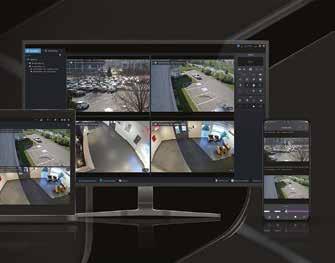
• With the ability to centralize the monitoring and management of multiple sites, Security Center SaaS is ideally suited to meet the needs of customers in a wide range of verticals, including retail, education, corporate campuses, banking, healthcare, and cities.
• It can serve low-density deployments with a handful of direct-to-cloud devices and scale up to thousands of sites and devices with hybrid storage and processing. Operators can manage operations from a SOC (Security Operation Center) or on the go through robust web and mobile applications.
• Security Center SaaS is a deployment-agnostic platform that supports a range of configurations. Based on a hybrid-SaaS architecture, the new solution allows organizations to move components and sites to the cloud based on their needs and requirements using a combination of cloud-native services and cloud-managed appliances, with storage and processing at the edge.
• Because of its open architecture, Security Center SaaS gives organizations the freedom to choose the devices, cameras, and door controllers that work best for their business.
End-user spending on security and risk management (SRM) in the Middle East and North Africa (MENA) region is forecast to total $3.3 billion in 2024, an increase of 12.1% from 2023, according to a new forecast from Gartner, Inc.
In 2024, spending on data privacy in MENA is projected to record the highest growth rate of all segments, increasing 24% year-over-year (see Table ).
Cloud security spending is expected to record an increase of 17.4%, the second highest growth rate in 2024. The growing use of infrastructure as a service (IaaS), platform as a service (PaaS), and software as a service (SaaS), is projected to drive spending on cloud security resources. The adoption of multi-cloud environments has also resulted in increased security complexities, which has boosted the demand for cloud-based detection and response solutions, such as endpoint detection and response and management tools.
The appearance of GenAI as a mainstream capability is causing significant disruptions in digital and business sectors. Gartner predicts that GenAI will cause a spike in the cybersecurity resources required to secure it, causing more than a 15% incremental spend on application and data security by 2025.
To effectively manage GenAI challenges and tackle other external factors, such as a shortage of security talent, growing regulatory concerns, and the rapid adoption of cloud technology, CISOs must prioritize two top cybersecurity trends. They will help improve
organizational resilience and the performance of the cybersecurity function.
• Exploring the Potential and Perils of GenAI – Large language model (LLM) applications, such as ChatGPT and Google Bard, have put GenAI on the agenda for inclusion in many business, IT and cybersecurity roadmaps.
Organizations must establish policies that govern the use of GenAI applications and develop training and guidance modules. This will help minimize unauthorized use of GenAI and decrease the risks of privacy and copyright infringement. Additionally, companies should update their application and data security practices to incorporate new attacks, such as the prompts or orchestration layers used to control AI models.
• Security Behavior and Culture Programs – The democratization of GenAI amplifies security challenges that organizations can face. Democratizing GenAI enables employees to have unrestricted access to powerful technical capabilities that, if used without due care, could result in data breaches.
Organizations need to implement security behavior and culture programs (SBCPs) to minimize cybersecurity incidents associated with employee behavior, whether inadvertent or deliberate. “Implementing effective SBCPs requires greater support and time commitments from senior executives and a shared vision of a secure enterprise that everyone in the organization can understand and support,” said Amato.


































